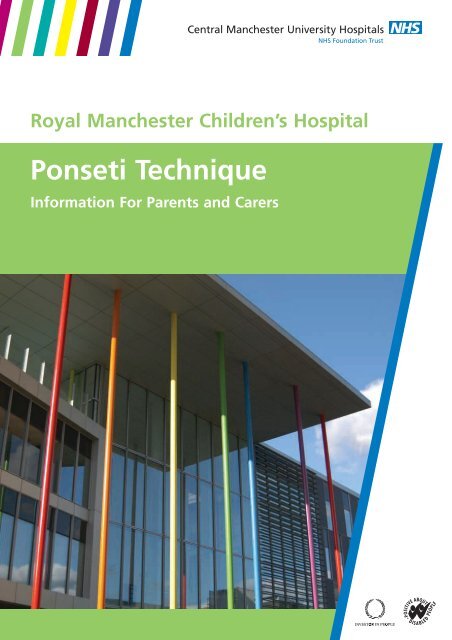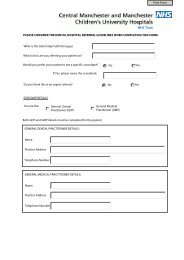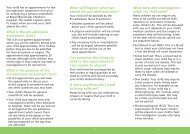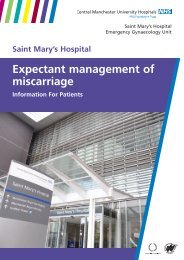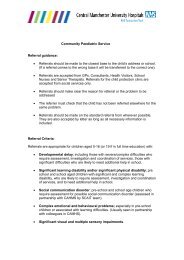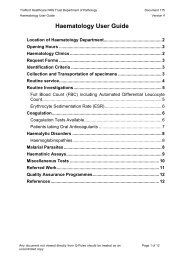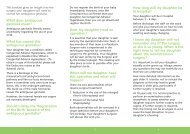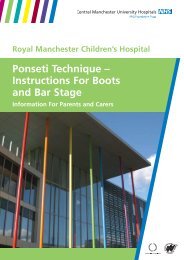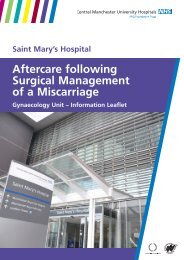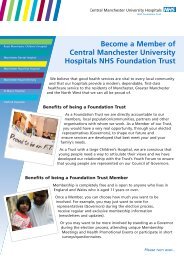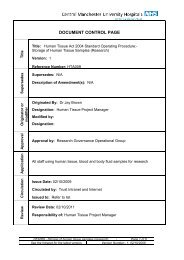Ponseti Technique - Central Manchester University Hospitals - NHS ...
Ponseti Technique - Central Manchester University Hospitals - NHS ...
Ponseti Technique - Central Manchester University Hospitals - NHS ...
- No tags were found...
Create successful ePaper yourself
Turn your PDF publications into a flip-book with our unique Google optimized e-Paper software.
Royal <strong>Manchester</strong> Children’s Hospital<strong>Ponseti</strong> <strong>Technique</strong>Information For Parents and Carers
The <strong>Ponseti</strong> techniqueYour child has been diagnosed as having Congenital TalipesEquinovarus (CTEV) or fixed talipes.The treatment that is recommended for your child is called the<strong>Ponseti</strong> technique.What is the <strong>Ponseti</strong> technique?It is a technique to straighten the feet, which has beensuccessfully used in the United States of America since the 1960sand in this country from around the year 2000.The treatment manipulates the soft bones of the foot andstretches the tight tissues. The foot is then held in place witha plaster cast. The cast is left on for 5 – 7 days. This lets themuscles and ligaments relax and the bones reshape into astraighter position.What happens next?At your child’s next clinic appointment, the plaster will beremoved using a plaster knife or a plaster saw, depending onthe child’s age.Your child can have a quick bath before their foot ismanipulated and put into a new plaster, which will hold theirfoot in the correct position.How many plasters will my child need?On average 4 – 6 plaster casts are needed to get the foot intothe correct position, but it may be more or less than this, asevery foot is different.3
How can I help?If you are bottle feeding it is useful to have your child’s feedwith you to offer them during their treatment, to keep themrelaxed. For an older child they can be distracted using a toyor snack or drink.If you are breast-feeding your child, it is also possible to applythe plaster as your child is being fed.You should change your child’s nappy regularly to avoid soilingof the plaster. Fit the leg of the nappy above the top of theplaster, to try and stop the plaster getting wet or dirty.Plaster careYou must:• Check your child’s toes are pink and warm at everynappy change.• Check your child’s toes can easily be seen and are in thesame position as when the plaster was first applied.• Check your child’s skin around the edges of the plasterfor any signs of the plaster rubbing, for example redness.• Keep the plaster dry.4
You must contact the hospital if:• You cannot see all your child’s toes.• Your child’s toes are not pink and warm.• The plaster becomes loose, cracked or crumbles.• Your child is crying more than usual and appears to beuncomfortable. It may be because the plaster is rubbingin an area that cannot be seen.Please use the telephone numbers listed on page 7.Will my child need an operation?Most children will need a small operation called a tenotomyto release the tight tendon at the back of their heel.This is done when your child’s foot has achieved a goodposition using plaster casts. The foot is then fully corrected.5
What happens after a tenotomy?• A plaster is put on for two to three weeks.• Your child will then be fitted with specially made bootsthat are joined together by a metal bar.• The boots and bar hold the feet in the corrected position.• They must be worn all the time for 3 months.• You can remove them once a day so your child can havea bath.• After 3 months, your child should wear the boots and barat night times and when asleep during the day in theirnormal sleeping place.• This will continue until your child is between 4 – 5 yearsof age.• During the day your child can wear well-fitting footwearof your choice.If you do not follow all the instructions, the treatmentis likely to be less successful.6
Useful web site addresseswww.ponseti.org.ukwww.steps-charity.org.ukwww.uihealthcare.com/topics/medicaldepartments/orthopaedics/clubfeet/index.htmlContact details• Miss Davis’ Secretary 0161 701 5356Monday – Friday9.00 am – 5.00 pm• Out-patient clinic 0161 701 9001Monday – Friday9.00 am – 5.00 pm• Ward 78 0161 701 7800/7802Out of normal working hours7
No Smoking PolicyThe <strong>NHS</strong> has a responsibility for the nation’s health.Protect yourself, patients, visitors and staff by adhering to ourno smoking policy. Smoking is not permitted within any of ourhospital buildings or grounds.The <strong>Manchester</strong> Stop Smoking Service can be contacted onTel: (0161) 205 5998 (www.stopsmokingmanchester.co.uk).Translation and Interpretation ServiceDo you have difficulty speaking or understanding English?☎ 0161 276 6202/6342Royal <strong>Manchester</strong> Children’s HospitalOxford Road<strong>Manchester</strong>M13 9WLwww.cmft.nhs.uk© Copyright to <strong>Central</strong> <strong>Manchester</strong> <strong>University</strong> <strong>Hospitals</strong> <strong>NHS</strong> Foundation TrustTIG 60/10 Produced April 2010 Review Date April 2012 (SF Taylor CM10769)


